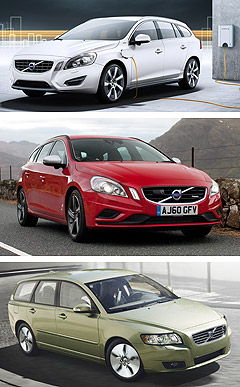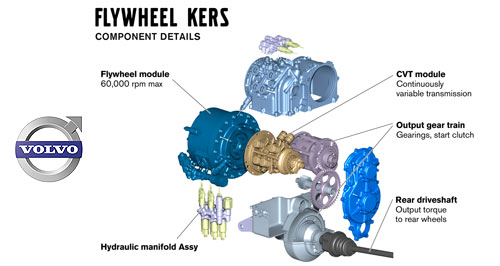Make / Model Search
News - VolvoVolvo in a spin for flywheel hybridFuel saver: Volvo's KERS system uses a super-fast flywheel to store brake energy, saving fuel and helping acceleration. Light-weight carbon fibre flywheel set for testing in Volvo energy recovery system1 Jun 2011 VOLVO Car Corporation has joined the ranks of companies testing flywheel-based kinetic energy recovery systems (KERS), this time using a smaller and lighter carbon fibre flywheel which it says can nevertheless reduce fuel consumption by 20 per cent and give a four-cylinder car six-cylinder-like acceleration. The Swedish company says the system has the potential to be cheaper than plug-in electric hybrid systems and be available with a few years. The flywheel is spun up to 60,000rpm when the car brakes, thus storing energy from the slowing car. Like an electric hybrid system, the energy is then transferred back into the drive line, helping to propel the car from standstill. In the Volvo device that is set for road trials in the second half of this year, the KERS unit drives the rear wheels of a front-drive car via a continuously variable transmission (CVT) and clutch. While most previous systems have employed weighty steel flywheels, Volvo has turned to carbon fibre to reduce the weight of the 20cm flywheel to just six kilograms, mitigating one of the main problems with such devices. As well, the flywheel turns in a vacuum to minimise frictional losses, allowing it to spin to huge speeds and maintain the pace longer.  Members of Volvo's green-fleet (from top): V60 Plug-in hybrid, V60 DRIVe and V50 DRIVe. Members of Volvo's green-fleet (from top): V60 Plug-in hybrid, V60 DRIVe and V50 DRIVe.Volvo says the system can generate a burst of power up to 60kW for short periods of acceleration. Jaguar is testing a similar system on an experimental XF in Britain, recording similar 20 per cent fuel savings in stop-start traffic. While the Jaguar system hooks into the rear-wheel-drive powertrain of the XF, the Volvo system is fitted to the back axle of a front-drive car – a layout that Volvo claims is a first. The principle of flywheel-based KERS has been around since the 1950s, with many motor companies looking at experimental systems for cars, trucks and buses. In road cars, companies such as Porsche considered flywheel systems for cars such as the 911, but dismissed them on the grounds of excess weight. The dream was revived via motor racing in 2009, with several formula one teams such as Williams developing mechanical KERS systems. Volvo, which has dabbled with flywheel technology in the past, said no manufacturer had applied such systems to the rear axle of a car fitted with a combustion engine driving the front wheels. Powertrain vice president Derek Crabb said that if the tests and technical development went as planned, Volvo expected cars with flywheel technology to reach the showrooms within a few years. "The flywheel technology is relatively cheap,” he said. “It can be used in a much larger volume of our cars than top-of-the-line technology such as the plug-in hybrid.” Mr Crabb said the flywheel system not only had the potential to cut fuel consumption but also reduce 0-100km/h acceleration times “significantly”. "The flywheel's stored energy is sufficient to power the car for short periods,” he said. “However, this has a major impact on fuel consumption. Our calculations indicate that the combustion engine will be able to be turned off about half the time when driving according to the official New European Driving Cycle.” Unlike petrol-electric hybrid systems that can store energy long-term in batteries, the spinning duration of the flywheel is limited, meaning it is really only beneficial in urban traffic. Volvo received a Swedish Energy Agency grant of 6.57 million kronor ($A1m) for the project which is a joint venture with bearing company SKF. The system also uses a special CVT from Torotrak Technology.  Read more |
Click to shareVolvo articlesResearch Volvo Motor industry news |











Facebook Twitter Instagram